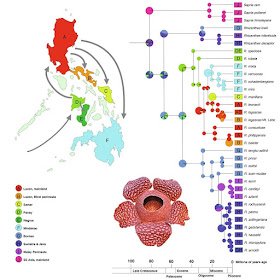 |
Pelser, Nickrent, van Ee & F. Barcelona, 2019.
|
Highlights
• Philippine Rafflesia is monophyletic.
• Rafflesia phylogeny displays strong biogeographic signal.
• Borneo probably constitutes the ancestral range of Rafflesia.
• Rafflesia lineages might be older and evolved more gradually than previously assumed.
• Rafflesia possibly disperse poorly between islands.
Abstract
Rafflesia (Rafflesiaceae) is a small endo-holoparasitic Asian plant genus known for its exceptionally large flowers, rare species, and high island endemism. In this study, phylogenetic (parsimony and Bayesian inference) and biogeographic (BioGeoBEARS) analyses of DNA sequence data (atp6 and matR genes, and nad1 B-C intron from the mitochondrial genome, and the nuclear ribosomal internal transcribed spacer) were used to reconstruct the phylogenetic relationships among 12 of the 13 known Philippine Rafflesia species and to determine the timing and pathways of their diversification. The results of these analyses confirm those of previous Rafflesia studies (which were largely focused on non-Philippine species) in finding pronounced biogeographic patterns. They suggest that dispersal between islands has been relatively uncommon, and indicate that the high island endemism of Rafflesia is a result of poor inter-island dispersal abilities. The results further suggest that its ancestral range might have been in Borneo, and that its lineages and species evolved earlier and more gradually than previously assumed.
Keywords: biogeography, dispersal, parasitic plants, divergence time, Malesia, parasitic plants
Pieter B. Pelser, Daniel L. Nickrent, Benjamin W. van Ee and Julie F. Barcelona. 2019. A Phylogenetic and Biogeographic Study of Rafflesia (Rafflesiaceae) in the Philippines: Limited Dispersal and High Island Endemism. Molecular Phylogenetics and Evolution. In Press. DOI: 10.1016/j.ympev.2019.106555




